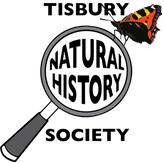|
Clive Whitbourn, National Trust Ranger, started his talk with a focus on Hambledon Hill, the 47 hectare hillfort which came to the National Trust in 2014. It is a Site of Special Scientific Interest and a photo from 1940 showed how bare the hillfort was 80 years ago. Now the hillfort is managed lightly, with scrub kept low and any erosion kept at bay with terrace reshaping to preserve the profile of the ramparts.
Clive showed us the methods they use with wooden frameworks buried deep to support hessian bags full of chalk, which bulk out any damaged areas, with turf from the ditch placed on top. The chalkland grasses grow through and thrive. He mentioned that the south and south-west ramparts of Hambledon Hill are best for butterflies. Cattle scraping for minerals – they can go on binges to self-medicate - and visitors wearing down paths, all play their part in erosion. Roboflail, a mechanical AI cutter, is being used on some of the NT sites to great effect to keep the scrub low and save the man hours for other tasks. The NT relies on volunteer help on many of their conservation projects. Hod Hill is Dorset’s largest Iron Age hillfort and is unusual because it has a Roman fort nestled within, built at a time when the invaders needed to defend their capture of this Durotriges stronghold. Clive showed us how the framework and hessian bag method was also used to repair a bridleway here. In terms of nature conservation, Texel sheep are good grazers and White Park cattle are brilliant for rough pastures. Yellow Rattle, which suppresses coarse grass growth, is doing well at Winn Green and there are plans this year to brush-harvest the seed from there and broadcast it to the newly purchased Clubmen’s Down, a 30 acre piece of arable. Across Clive’s patch and the various Downs and hillforts, uncommon species are being noted: Bee and the Great Butterfly orchids, and the unusual Autumn Lady’s Tresses; Waxcap fungi; Marsh, Silver-spotted and Danville Fritillaries, Grizzled Skippers, Small Blue and Adonis Blue butterflies; Great Green Bush-crickets and Glow worms. Clive’s talk gave us plenty of inspiration for visiting these places, particularly in the spring and summer! Comments are closed.
|
Photo: Avocets (Izzy Fry)
The headers display photos taken by our members. Do get in touch via the Contact Form if you'd like to submit a photo for selection.
Archives
May 2024
Categories
All
|

 RSS Feed
RSS Feed